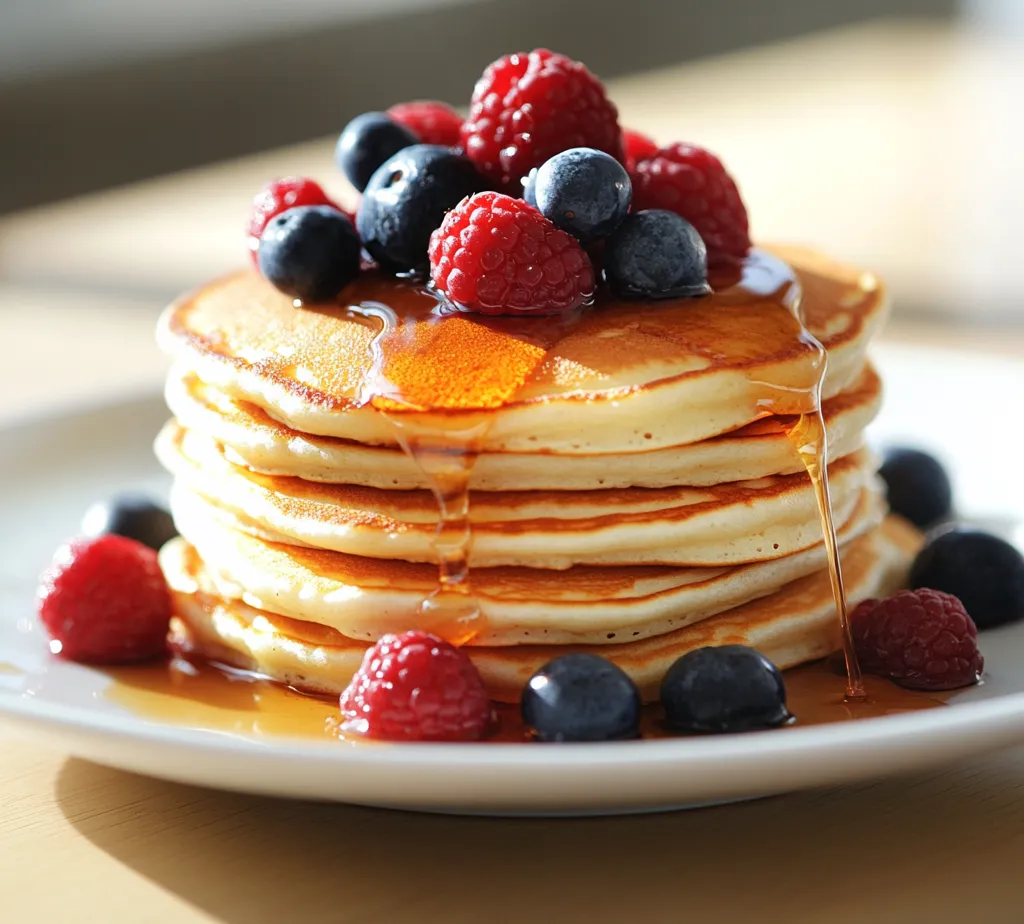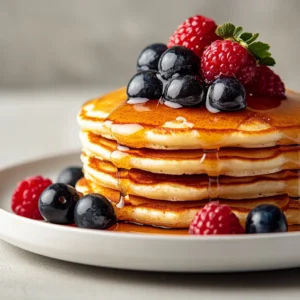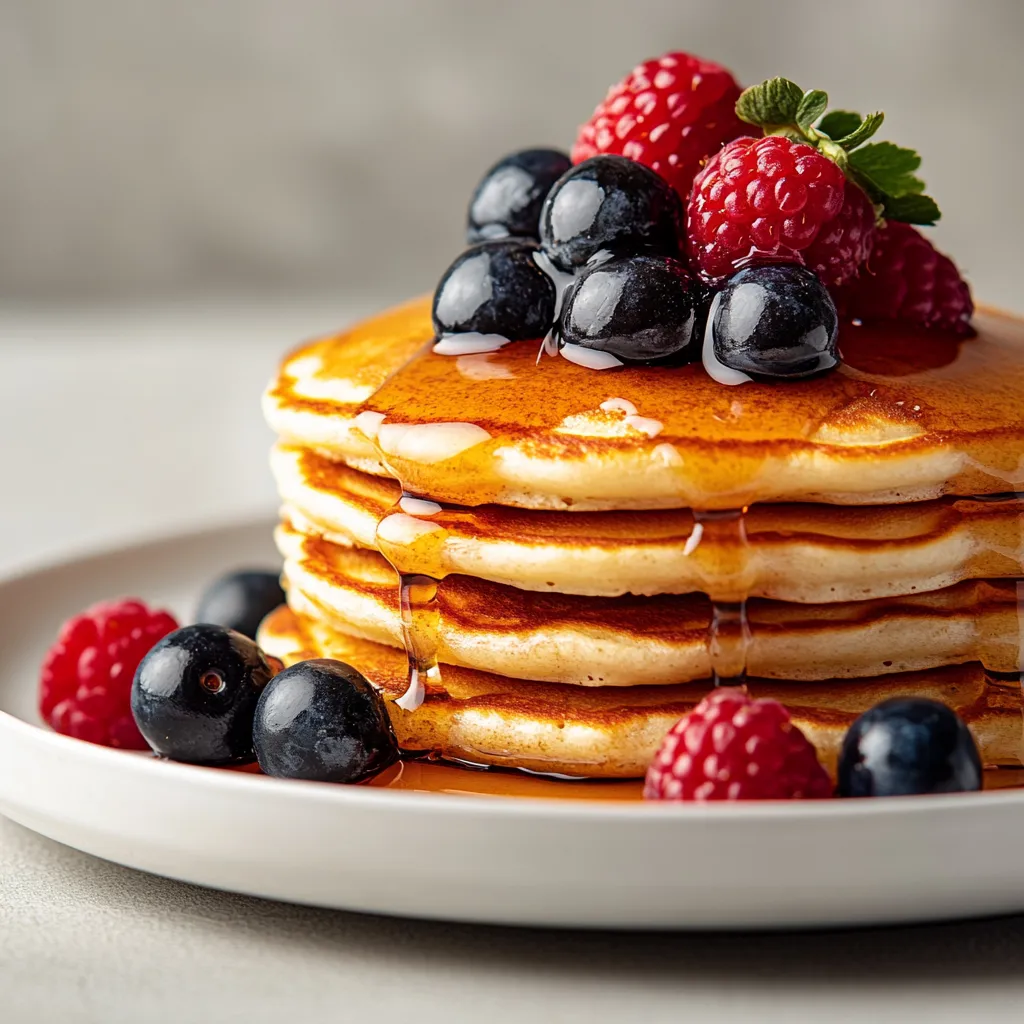Introduction
Explore the world of fluffy pancakes with this Fluffy Delight Pancakes Recipe that promises to be a breakfast favorite for everyone at your table. Perfectly light and airy, these pancakes are the ideal canvas for any toppings you choose. Made with simple and wholesome ingredients, this recipe ensures that anyone can whip up a stack of fluffy delight pancakes in just moments. Whether enjoyed during a leisurely weekend brunch or a hurried weekday breakfast, these pancakes deliver satisfying warmth and comfort.
The beauty of this Fluffy Delight Pancakes Recipe lies in its versatility. You can customize it with various toppings or mix-ins, making it a delightful dish for all tastes. Fresh berries, chocolate chips, and chopped nuts are just a few options, allowing you to cater to your family’s preferences. Furthermore, they are easy to prepare, requiring minimal equipment and ingredients, making them perfect for both novice cooks and seasoned chefs alike.
Recipe Overview
– Total Time: 20 minutes
– Yield/Servings: 4 servings
– Difficulty: Not specified in the recipe
This straightforward recipe lays the foundation for creating fluffy pancakes that everyone will love. With just a handful of ingredients, you can whip up a delightful stack of pancakes that are both simple and versatile. Accompanied by tips on customizing flavors and textures, this recipe will become a staple in your breakfast repertoire.
Ingredients
– 1 cup all-purpose flour
– 2 tablespoons granulated sugar
– 1 tablespoon baking powder
– 1/2 teaspoon fine sea salt
– 1 cup milk (use whole milk or buttermilk for an extra fluffy texture)
– 1 large egg
– 2 tablespoons unsalted butter, melted (plus additional for cooking)
– 1 teaspoon pure vanilla extract
– Optional: Fresh berries, chocolate chips, or chopped nuts for topping

Instructions
1. Mix Dry Ingredients: In a spacious mixing bowl, combine the all-purpose flour, sugar, baking powder, and salt. Whisk together until the mixture is uniform and free of lumps.
2. Combine Wet Ingredients: In a separate bowl, whisk together the milk, egg, melted butter, and vanilla extract until the mixture is well blended and smooth.
3. Combine Mixtures: Carefully pour the wet ingredients into the bowl with the dry ingredients. Gently fold the mixtures together using a spatula or wooden spoon until just combined—it’s perfectly fine to have some small lumps, as this will help create fluffy pancakes.
4. Preheat Skillet: Heat a non-stick skillet or griddle over medium heat. Add a small pat of butter to lightly coat the surface, ensuring a non-stick cooking experience.
5. Cook Pancakes: For each pancake, pour approximately 1/4 cup of batter onto the skillet. Allow them to cook until bubbles begin to form on the surface and the edges appear set, which should take about 2-3 minutes. Carefully flip the pancakes and cook for an additional 1-2 minutes until they are golden brown on both sides.
6. Keep Warm: Once cooked, transfer the pancakes to a plate and keep them warm in a low-temperature oven while you continue cooking the remaining batter.
7. Serve: Create an impressive stack of pancakes and serve them with your choice of toppings such as fresh berries, a drizzle of syrup, a dollop of whipped cream, or a light dusting of powdered sugar for an extra touch of sweetness.
Mixing Dry Ingredients
Selecting appropriate containers is crucial when preparing your pancake batter. A spacious mixing bowl is essential for incorporating your dry ingredients effectively. As you combine the flour, sugar, baking powder, and salt, it’s important to whisk them thoroughly, achieving a blend that is uniform and devoid of lumps. This step is critical, as each dry ingredient contributes uniquely to the final flavor and texture of the pancakes.
The all-purpose flour provides structure, while the granulated sugar adds a touch of sweetness. Baking powder is the vital leavening agent that introduces lightness and fluffiness to the pancakes. Finally, the fine sea salt enhances the overall flavor balance, preventing the pancakes from tasting bland. Thoroughly whisking these ingredients ensures that the baking powder is evenly distributed, which is essential for even rising during cooking.
Combining Wet Ingredients
The choice of milk is an integral part of your pancake batter. Whole milk or buttermilk are the recommended options for achieving a rich and fluffy texture. Whole milk lends a satisfying creaminess, while buttermilk introduces a slight tang and promotes leavening through its acidity. Whichever option you choose, ensure that it is at room temperature, as this can significantly impact the consistency of your batter. Room temperature ingredients often blend more smoothly, resulting in a more homogenous pancake batter.
When it comes to whisking the wet ingredients together, it’s best to combine the milk, large egg, melted unsalted butter, and pure vanilla extract until they are well blended and smooth. This creates a cohesive mixture that integrates seamlessly with the dry ingredients. The melted butter not only adds richness but also contributes to the moisture of the pancakes, while the vanilla extract infuses a warm, aromatic flavor that elevates the overall taste experience.
With these foundational elements, you’ll be well on your way to creating the most delightful pancakes.

Combining Mixtures
Folding Technique
When combining your wet and dry ingredients, employ a gentle folding technique to avoid overmixing the batter. This involves using a spatula to scoop from the bottom of the bowl and gently lift the mixture over itself. As you fold, focus on incorporating the ingredients rather than vigorously mixing them together. This method helps maintain the air pockets created during whisking, which is essential for achieving the light and fluffy texture of the pancakes.
Understanding the Lumpy Batter Concept
It’s important to remember that small lumps in your pancake batter are not only acceptable but beneficial. These lumps indicate that the batter hasn’t been overmixed, allowing air bubbles to remain trapped in the mixture. When these air pockets heat during cooking, they expand, leading to light and airy pancakes. Therefore, resist the urge to achieve a perfectly smooth batter.
Avoiding Overmixing
Overmixing pancake batter can lead to a dense and rubbery final product due to the gluten development in the flour. When gluten is overactivated, it can create a less-than-ideal chewy texture. To avoid this, aim for a mixture that is just combined, leaving some lumps in the batter as a guarantee for fluffy pancakes.
Preheating the Skillet
Choosing the Right Cookware
Opting for a non-stick skillet or griddle is highly recommended for cooking pancakes. This type of cookware allows for easy release and ensures that the pancakes do not stick to the surface, resulting in less damage to their delicate structure. Additionally, a non-stick pan requires less oil or butter, creating a healthier and cleaner cooking experience.
Ideal Temperature Setting
Setting the skillet to medium heat is crucial for cooking pancakes evenly. If the skillet is too hot, the pancakes will cook too quickly on the outside while remaining raw in the center. Conversely, a skillet that is not hot enough will yield pancakes that are dense and heavy. A properly preheated pan allows for even cooking and a perfect golden-brown finish.
Buttering the Pan
When buttering the pan, it’s best to use a small pat and let it melt completely before adding the batter. Swirl the melted butter to evenly coat the surface, which not only prevents sticking but also adds a rich flavor to the pancakes. If you notice any excess butter pooling in the skillet, use a paper towel to dab away the extra grease to help achieve even browning.
Cooking Pancakes
Pouring the Batter
For each pancake, pour approximately 1/4 cup of batter onto the skillet. This measurement is ideal for creating pancakes that are thick and fluffy while ensuring they are not overwhelmingly large. Using a measuring cup can help maintain portion consistency and ease of cooking.
Identifying Cooking Signals
Cooking signals are essential to perfect pancakes. Keep an eye on the surface of the pancake for bubbles that form and begin to burst; this typically occurs after 2-3 minutes. Additionally, check the edges of the pancake—if they appear set and slightly dry, it’s time to flip. These indicators ensure even cooking and optimal texture.
Flipping Techniques
When it comes time to flip, use a spatula to slide beneath the pancake and gently lift it up. A quick wrist movement can help you flip the pancake over with confidence. It’s advisable to flip it once the first side is a nice golden brown to guarantee an even cooking on the other side. Avoid pressing down on the pancake after flipping, as this could make it denser.
Keeping Pancakes Warm
Oven Temperature Recommendations
To keep pancakes warm while cooking, set your oven to a low temperature of around 200°F (93°C). This temperature is sufficient to keep pancakes warm without further cooking them, ensuring that they retain their fluffy texture. Place a heat-proof plate or a baking sheet lined with parchment paper in the oven for convenience.
Storing Cooked Pancakes
Keeping pancakes warm is essential for a cohesive dining experience, particularly if you have guests. If you have cooked more pancakes than can be served at once, stacking them on a plate in the warm oven will help maintain their ideal temperature and texture until ready to serve.
Serving Suggestions
Creating the Perfect Stack
When serving pancakes, layering them can create an impressive presentation. Start with one pancake, add a sprinkle of nuts or chocolate chips, add another pancake, and repeat. This not only adds visual appeal but also incorporates additional textures and flavors, enhancing the overall experience.
Topping Ideas
Diversifying topping combinations can greatly enhance your pancake experience. Besides the standard maple syrup, consider fresh berries like blueberries or raspberries, whipped cream, and a dusting of powdered sugar. Additionally, try flavored syrups or sauces such as caramel or nut butter to provide different flavor profiles.
Presentation Tips
Garnishing is key to elevating pancake presentation. A light drizzle of syrup or a dollop of whipped cream can add both flavor and visual interest. Adding fresh mint leaves or a scatter of edible flowers can also contribute to an appealing look. The addition of colorful toppings can entice your guests, making breakfast feel like a special occasion.
Customizing Flavors
Flavor Variations
For unique flavor profiles, consider adding spices like cinnamon or nutmeg directly into the dry ingredients. You might also incorporate citrus zest from lemons or oranges into the wet mixture for a bright, refreshing twist. Extracts, such as almond or coconut extract, can also provide an interesting background flavor without overwhelming the traditional pancake taste.
Seasonal Ingredients
Take advantage of seasonal ingredients to enhance your pancakes throughout the year. During fall, consider using pumpkin puree and spices for a seasonal approach. In summer, use fresh fruits like peaches or melons to infuse seasonal flavors into the pancakes.
Dietary Alternatives
Although the base recipe calls for all-purpose flour and dairy, those with dietary needs can explore gluten-free flour alternatives, ensuring they’re blended correctly for texture. Dairy-free, plant-based milk and oil can replace whole milk and butter, creating suitable options for those avoiding dairy.
Conclusion
This Fluffy Delight Pancakes Recipe provides a perfect base for a light and airy breakfast. The techniques emphasized in mixing and cooking ensure a consistently fluffy pancake that can be enjoyed topped with a variety of delicious options. With a quick total time of just 20 minutes, these pancakes are an ideal choice for a comforting yet indulgent morning meal.

Fluffy Delight Pancakes Recipe
Ingredients
- 1 cup all-purpose flour
- 2 tablespoons granulated sugar
- 1 tablespoon baking powder
- ½ teaspoon fine sea salt
- 1 cup milk
- 1 large egg
- 2 tablespoons unsalted butter melted
- 1 teaspoon pure vanilla extract
- Optional: Fresh berries chocolate chips, or chopped nuts for topping
Instructions
- In a mixing bowl, combine flour, sugar, baking powder, and salt.
- In another bowl, whisk together milk, egg, melted butter, and vanilla extract.
- Pour wet ingredients into dry ingredients and fold gently until just combined.
- Preheat a non-stick skillet over medium heat and add a small pat of butter.
- Pour ¼ cup of batter onto the skillet for each pancake.
- Cook until bubbles form on the surface, about 2-3 minutes, then flip.
- Cook for an additional 1-2 minutes until golden brown on both sides.
- Transfer pancakes to a plate and keep warm in a low-temperature oven.
- Serve with toppings like fresh berries, syrup, or whipped cream.

